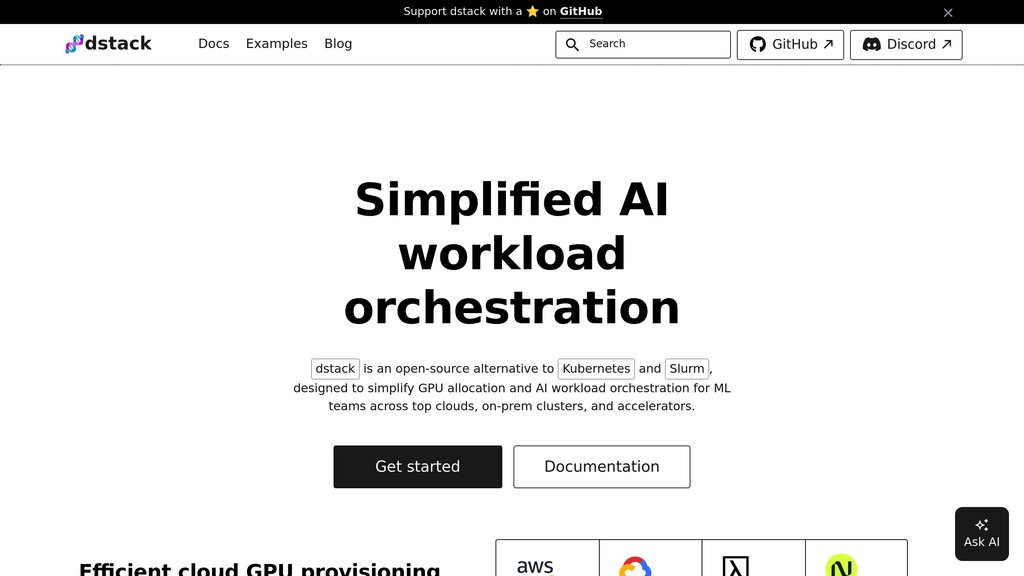dstack
Open-source container orchestration platform tailored for AI workloads, enabling seamless GPU resource management across cloud and on-premises environments.
Community:
Product Overview
What is dstack?
dstack is a streamlined alternative to Kubernetes and Slurm, designed specifically to simplify container orchestration for AI development, training, and deployment. It supports a wide range of accelerators including NVIDIA, AMD, Google TPU, Intel Gaudi, and Tenstorrent, and works seamlessly across major cloud providers as well as on-premises clusters. dstack offers unified interfaces for managing development environments, scheduling distributed tasks, deploying scalable model services, handling fleets of GPU clusters, and managing persistent storage volumes. Its configuration is YAML-based, enabling easy version control and automation. By abstracting infrastructure complexity, dstack accelerates AI workflows and reduces operational overhead for ML teams.
Key Features
Accelerator and Cloud Agnostic
Supports multiple GPU and AI accelerators such as NVIDIA, AMD, TPU, Intel Gaudi, and Tenstorrent, and integrates with all major cloud providers as well as on-premises servers.
Unified AI Workflow Interfaces
Provides dedicated configurations for dev environments, task scheduling, service deployment with auto-scaling, fleet management, and persistent volumes to cover the entire AI lifecycle.
Simplified Configuration and Automation
Uses declarative YAML files for defining environments, jobs, services, and clusters, applied via a simple CLI or API, automating provisioning, scaling, and networking.
Cost-Effective Multi-Cloud and On-Prem Management
Enables flexible use of cloud and on-prem resources without vendor lock-in, optimizing GPU utilization and cloud costs.
Open Source with Extensible Ecosystem
100% open source with active development, supporting integration with popular AI frameworks and tools like PyTorch, HuggingFace, and vLLM.
Use Cases
- Interactive Development Environments : Spin up remote GPU-powered dev environments accessible from desktop IDEs for rapid experimentation and coding.
- Distributed Training and Fine-Tuning : Schedule and run complex training jobs across clusters or single nodes with support for frameworks like DeepSpeed and HuggingFace Accelerate.
- Model Deployment and Inference : Deploy scalable, secure, and auto-scaling model endpoints compatible with custom serving frameworks and OpenAI APIs.
- Cluster and Fleet Management : Manage heterogeneous GPU clusters across clouds and on-premises, enabling efficient resource sharing and scaling.
- Persistent Storage for AI Workloads : Use network volumes to persist datasets, checkpoints, and cache across multiple runs and environments.
FAQs
dstack Alternatives
Defang
A streamlined platform that transforms Docker Compose projects into secure, scalable cloud deployments with minimal effort.
Tensorfuse
Serverless GPU runtime enabling seamless deployment, fine-tuning, and autoscaling of AI models on private cloud infrastructure.
Modelbit
Infrastructure-as-code platform for seamless deployment, scaling, and management of machine learning models in production.
UbiOps
A flexible platform for deploying, managing, and orchestrating AI and ML models across cloud, on-premise, and hybrid environments.
Brainboard
A collaborative platform for visually designing, generating, and managing cloud infrastructure with automated Terraform code generation.
Movestax
An all-in-one serverless-first cloud platform designed to simplify app deployment, serverless databases, workflow automation, and infrastructure management for modern developers.
Pipekit
A scalable control plane for managing and optimizing Argo Workflows on Kubernetes, enabling efficient data and CI pipeline operations.
Release
Platform for creating and managing on-demand, ephemeral environments that accelerate development workflows and optimize DevOps costs.
Analytics of dstack Website
🇺🇸 US: 44.55%
🇮🇩 ID: 16.92%
🇮🇳 IN: 14.07%
🇩🇪 DE: 13.65%
🇻🇳 VN: 9.04%
Others: 1.77%
